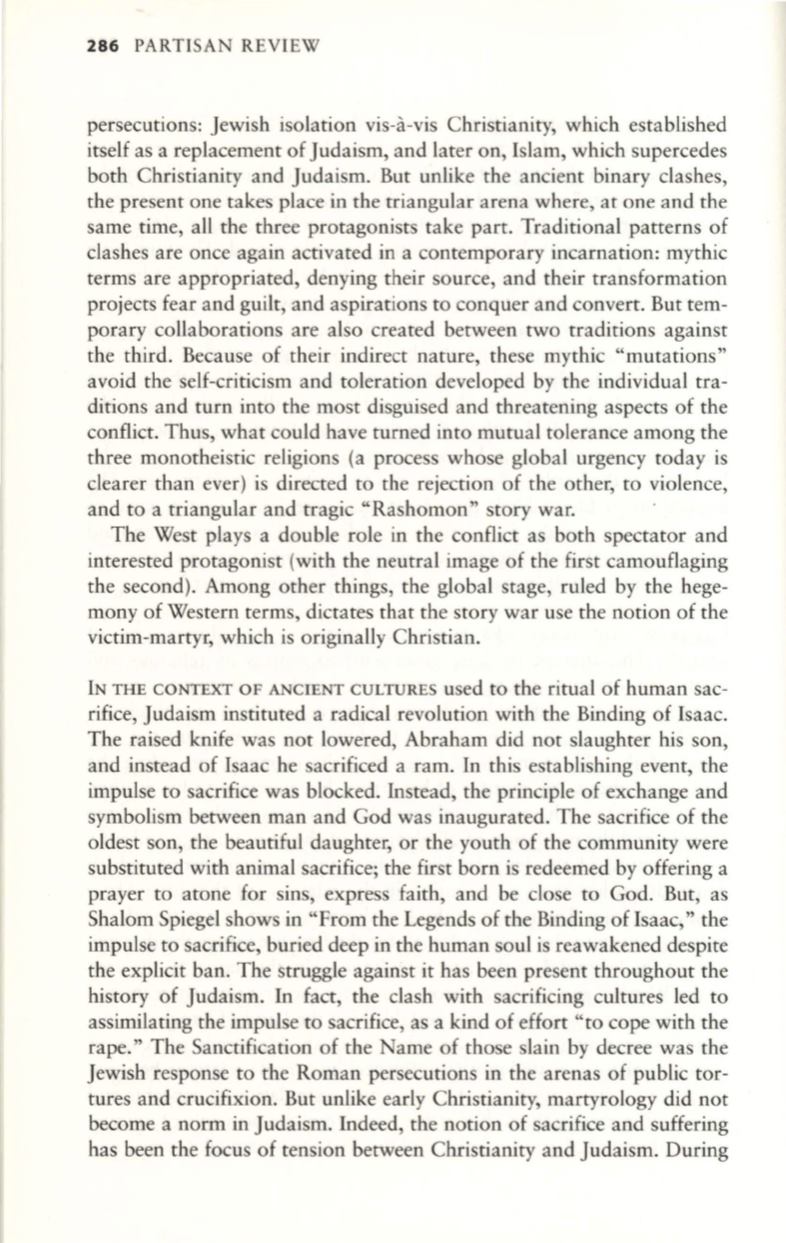
286
PARTISAN REVIEW
persecutions: Jewish isolation vis-a-vis Christianity, which established
itself as a replacement of Judaism, and later on, Islam, which supercedes
both Christianity and Judaism. But unlike the ancient binary clashes,
the present one takes place in the triangular arena where, at one and the
same time, all the three protagonists take part. Traditional patterns of
clashes are once again activated in a contemporary incarnation: mythic
terms are appropriated, denying their source, and their transformation
projects fear and guilt, and aspirations to conquer and convert. But tem–
porary collaborations are also created between two traditions against
the third. Because of their indirect nature, these mythic "mutations"
avoid the self-criticism and toleration developed by the individual tra–
ditions and turn into the most disguised and threatening aspects of the
conflict. Thus, what could have turned into mutual tolerance among the
three monotheistic religions (a process whose global urgency today is
clearer than ever) is directed to the rejection of the other, to violence,
and to a triangular and tragic "Rashomon" story war.
The West plays a double role in the conflict as both spectator and
interested protagonist (with the neutral image of the first camouflaging
the second). Among other things, the global stage, ruled by the hege–
mony of Western terms, dictates that the story war use the notion of the
victim-martyr, which is originally Christian.
IN THE CONTEXT OF ANCIENT CULTURES used to the ritual of human sac–
rifice, Judaism instituted a radical revolution with the Binding of Isaac.
The raised knife was not lowered, Abraham did not slaughter his son,
and instead of Isaac he sacrificed a ram. In this establishing event, the
impulse to sacrifice was blocked. Instead, the principle of exchange and
symbolism between man and God was inaugurated. The sacrifice of the
oldest son, the beautiful daughter, or the youth of the community were
substituted with animal sacrifice; the first born is redeemed by offering a
prayer to atone for sins, express faith, and be close to God. But, as
Shalom Spiegel shows in "From the Legends of the Binding of Isaac," the
impulse to sacrifice, buried deep in the human soul is reawakened despite
the explicit ban. The struggle against it has been present throughout the
history of Judaism. In fact, the clash with sacrificing cultures led to
assimilating the impulse to sacrifice, as a kind of effort "to cope with the
rape." The Sanctification of the Name of those slain by decree was the
Jewish response to the Roman persecutions in the arenas of public tor–
tures and crucifixion. But unlike early Christianity, martyrology did not
become a norm in Judaism. Indeed, the notion of sacrifice and suffering
has been the focus of tension between Christianity and Judaism. During


